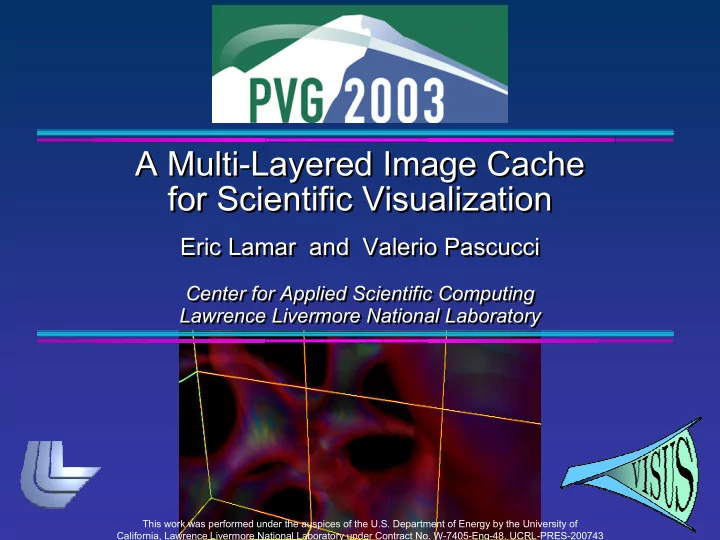

A Multi-Layered Image Cache A Multi-Layered Image Cache for Scientific Visualization for Scientific Visualization Eric Lamar and Valerio Pascucci Eric Lamar and Valerio Pascucci Center for Applied Scientific Computing Center for Applied Scientific Computing Lawrence Livermore National Laboratory Lawrence Livermore National Laboratory PVG-03-1 This work was performed under the auspices of the U.S. Department of Energy by the University of Valerio Pascucci California, Lawrence Livermore National Laboratory under Contract No. W-7405-Eng-48. UCRL-PRES- 200743
Visual data exploration requires interactive visualization tools. � The user is less frustrated by transient artifacts then by slow refresh rates. � “Interactive display” is not synonym with “interactive rendering.” � One obstacle to scalable visualization is the need to render everything within a single frame. � A possible solution is to decouple the rendering from the display. PVG-03-2 Valerio Pascucci
We develop a hybrid approach to generic asynchronous rendering. We use a light weighted display engine that reads images retrieved from a small local database. PVG-03-3 Valerio Pascucci
We develop a hybrid approach to generic asynchronous rendering. When an image is not available a request is posted to the “work queue.” When a request is satisfied the image database is updated and a notification is posted to the “done queue.” PVG-03-4 Valerio Pascucci
We develop a hybrid approach to generic asynchronous rendering. Multiple rendering engines can access the queues at the same time to achieve parallelism. PVG-03-5 Valerio Pascucci
We develop a hybrid approach to generic asynchronous rendering. The queues can be accessed remotely to tackle distributed rendering resources. PVG-03-6 Valerio Pascucci
We develop a view-centric decomposition of the scene. A standard cube is anchored around the view point. The view frustum intersects some of the cube faces. PVG-03-7 Valerio Pascucci
Transient artifacts appear after a translation of the point of view. Rotation and zoom do not invalidate the current images. After a translation the entire image database is invalid but the old images are used until replaced. PVG-03-8 Valerio Pascucci
A view-dependent refinement is performed on each cube face. A pyramidal Kd-tree A binary tree of tiles of refinement is performed equal resolution is in image space. maintained in the image database. PVG-03-9 Valerio Pascucci
At each view a Kd-tree refinement determines the new working set. View 1 View 2 The refinement determines the new images needed. PVG-03-10 Valerio Pascucci
Horizontal/vertical refinements require simple image stretching. PVG-03-11 Valerio Pascucci
Horizontal/vertical refinements require simple image stretching. The missing images are temporarily extrapolated from those available. PVG-03-12 Valerio Pascucci
Front-back refinement requires inverse compositing refinement. C 0 = C 1 + C 2 (1- α 0 ) α 0 = α 0 + α 1 (1- α 0 ) C 1 = C 2 = C 0 / (2- α 0 ) α 1 = α 2 = 1 - √ 1- α 0 Level 1 Level 2 PVG-03-13 Valerio Pascucci
We use two queues to avoid producer-consumer contention. The display engine does not block the access of the rendering engine. Tail Head PVG-03-14 Valerio Pascucci
Contention among rendering engines is not problematic. The asynchronous nature of the system and the granularity of the work mitigates contention of rendering engines. Tail Head PVG-03-15 Valerio Pascucci
We tested the scalability of the image cache on two platforms. SGI Origin 3000, 48 processors (250MHz R10k) Linux cluster, 64 nodes (2.5GHz Pentium) We tested the following parameters of the system: – number of images in the scene – number of rendering servers – size of the images – pixels per second – network bandwidth utilization PVG-03-16 Valerio Pascucci
Display speed is inversely proportional to number of Images. PVG-03-17 Valerio Pascucci
Fill-rate performance suggest one particular image size. PVG-03-18 Valerio Pascucci
Sustained bandwidth utilization close to ideal pick performance. PVG-03-19 Valerio Pascucci
The system scales well with the number of processing units. PVG-03-20 Valerio Pascucci
The system scales well with the number of processing units. PVG-03-21 Valerio Pascucci
The behavior of the system is consistent across platforms. PVG-03-22 Valerio Pascucci
Current directions � Heterogeneous distributed system. � Combined multi-resolution representation of the object. � Scaling to high resolution output power-walls. � Combination with other techniques? � Development of prediction agents for data pre-fetching. PVG-03-23 Valerio Pascucci
UCRL-PRES- 200743 � This work was performed under the auspices of the U.S. Department of Energy by University of California Lawrence Livermore National Laboratory under contract No. W-7405-ENG-48. PVG-03-24 Valerio Pascucci
Recommend
More recommend